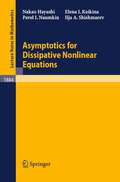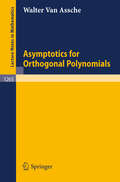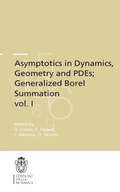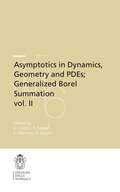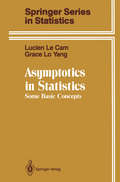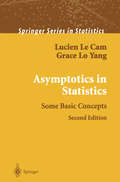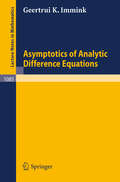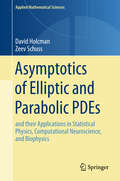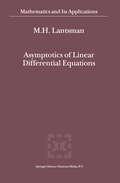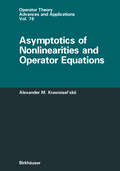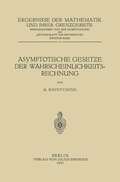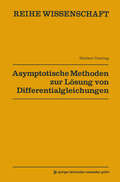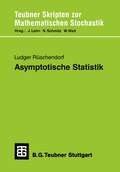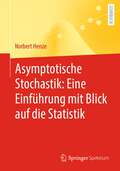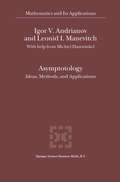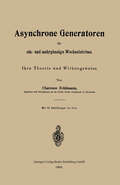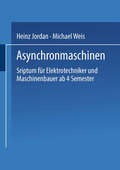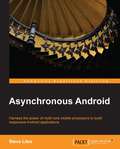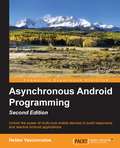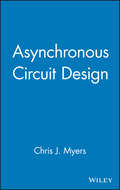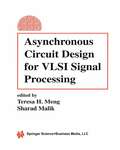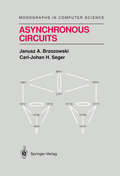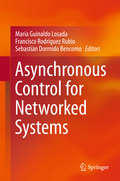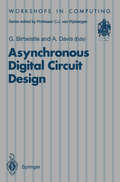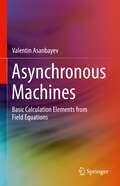- Table View
- List View
Asymptotics for Dissipative Nonlinear Equations (Lecture Notes in Mathematics #1884)
by Nakao Hayashi Elena I. Kaikina Pavel Naumkin Ilya A. ShishmarevThis is the first book in world literature giving a systematic development of a general asymptotic theory for nonlinear partial differential equations with dissipation. Many typical well-known equations are considered as examples, such as: nonlinear heat equation, KdVB equation, nonlinear damped wave equation, Landau-Ginzburg equation, Sobolev type equations, systems of equations of Boussinesq, Navier-Stokes and others.
Asymptotics for Orthogonal Polynomials (Lecture Notes in Mathematics #1265)
by Walter Van AsscheRecently there has been a great deal of interest in the theory of orthogonal polynomials. The number of books treating the subject, however, is limited. This monograph brings together some results involving the asymptotic behaviour of orthogonal polynomials when the degree tends to infinity, assuming only a basic knowledge of real and complex analysis. An extensive treatment, starting with special knowledge of the orthogonality measure, is given for orthogonal polynomials on a compact set and on an unbounded set. Another possible approach is to start from properties of the coefficients in the three-term recurrence relation for orthogonal polynomials. This is done using the methods of (discrete) scattering theory. A new method, based on limit theorems in probability theory, to obtain asymptotic formulas for some polynomials is also given. Various consequences of all the results are described and applications are given ranging from random matrices and birth-death processes to discrete Schrödinger operators, illustrating the close interaction with different branches of applied mathematics.
Asymptotics in Dynamics, Geometry and PDEs; Generalized Borel Summation: Proceedings of the conference held in CRM Pisa, 12-16 October 2009, Vol. I (Publications of the Scuola Normale Superiore #12.1)
by Édéric Menous David Sauzin Ovidiu Costin Édéric FauvetThese are the proceedings of a one-week international conference centered on asymptotic analysis and its applications. They contain major contributions dealing with - mathematical physics: PT symmetry, perturbative quantum field theory, WKB analysis, - local dynamics: parabolic systems, small denominator questions, - new aspects in mould calculus, with related combinatorial Hopf algebras and application to multizeta values, - a new family of resurgent functions related to knot theory.
Asymptotics in Dynamics, Geometry and PDEs; Generalized Borel Summation: Proceedings of the conference held in CRM Pisa, 12-16 October 2009, Vol. II (Publications of the Scuola Normale Superiore #12.2)
by Édéric Menous David Sauzin Ovidiu Costin Édéric FauvetThese are the proceedings of a one-week international conference centered on asymptotic analysis and its applications. They contain major contributions dealing with: mathematical physics: PT symmetry, perturbative quantum field theory, WKB analysis, local dynamics: parabolic systems, small denominator questions, new aspects in mould calculus, with related combinatorial Hopf algebras and application to multizeta values, a new family of resurgent functions related to knot theory.
Asymptotics in Statistics: Some Basic Concepts (Springer Series in Statistics)
by Lucien Le Cam Grace Lo YangIn the summer of 1968 one of the present authors (LLC) had the pleasure of giving a sequence of lectures at the University of Mon treal. Lecture notes were collected and written out by Drs. Catherine Doleans, Jean Haezendonck and Roch Roy. They were published in French by the Presses of the University of Montreal as part of their series of Seminaires de Mathematiques Superieures. Twenty years later it was decided that a Chinese translation could be useful, but upon prodding by Professor Shanti Gupta at Purdue we concluded that the notes should be updated and rewritten in English and in Chinese. The present volume is the result of that effort. We have preserved the general outline of the lecture notes, but we have deleted obsolete material and sketched some of the results acquired during the past twenty years. This means that while the original notes concentrated on the LAN situation we have included here some results of Jeganathan and others on the LAMN case. Also included are versions of the Hajek-Le Cam asymptotic minimax and convolution theorems with some of their implications. We have not attempted to give complete coverage of the subject and have often stated theorems without indicating their proofs.
Asymptotics in Statistics: Some Basic Concepts (Springer Series in Statistics)
by Lucien Le Cam Grace Lo YangThis is the second edition of a coherent introduction to the subject of asymptotic statistics as it has developed over the past 50 years. It differs from the first edition in that it is now more 'reader friendly' and also includes a new chapter on Gaussian and Poisson experiments, reflecting their growing role in the field. Most of the subsequent chapters have been entirely rewritten and the nonparametrics of Chapter 7 have been amplified. The volume is not intended to replace monographs on specialized subjects, but will help to place them in a coherent perspective. It thus represents a link between traditional material - such as maximum likelihood, and Wald's Theory of Statistical Decision Functions -- together with comparison and distances for experiments. Much of the material has been taught in a second year graduate course at Berkeley for 30 years.
Asymptotics of Elliptic and Parabolic PDEs: and their Applications in Statistical Physics, Computational Neuroscience, and Biophysics (Applied Mathematical Sciences #199)
by David Holcman Zeev SchussThis is a monograph on the emerging branch of mathematical biophysics combining asymptotic analysis with numerical and stochastic methods to analyze partial differential equations arising in biological and physical sciences. In more detail, the book presents the analytic methods and tools for approximating solutions of mixed boundary value problems, with particular emphasis on the narrow escape problem. Informed throughout by real-world applications, the book includes topics such as the Fokker-Planck equation, boundary layer analysis, WKB approximation, applications of spectral theory, as well as recent results in narrow escape theory. Numerical and stochastic aspects, including mean first passage time and extreme statistics, are discussed in detail and relevant applications are presented in parallel with the theory. Including background on the classical asymptotic theory of differential equations, this book is written for scientists of various backgrounds interested in deriving solutions to real-world problems from first principles.
Asymptotics of Linear Differential Equations (Mathematics and Its Applications #533)
by M.H. LantsmanThe asymptotic theory deals with the problern of determining the behaviour of a function in a neighborhood of its singular point. The function is replaced by another known function ( named the asymptotic function) close (in a sense) to the function under consideration. Many problems of mathematics, physics, and other divisions of natural sci ence bring out the necessity of solving such problems. At the present time asymptotic theory has become an important and independent branch of mathematical analysis. The present consideration is mainly based on the theory of asymp totic spaces. Each asymptotic space is a collection of asymptotics united by an associated real function which determines their growth near the given point and (perhaps) some other analytic properties. The main contents of this book is the asymptotic theory of ordinary linear differential equations with variable coefficients. The equations with power order growth coefficients are considered in detail. As the application of the theory of differential asymptotic fields, we also consider the following asymptotic problems: the behaviour of explicit and implicit functions, improper integrals, integrals dependent on a large parameter, linear differential and difference equations, etc .. The obtained results have an independent meaning. The reader is assumed to be familiar with a comprehensive course of the mathematical analysis studied, for instance at mathematical departments of universities. Further necessary information is given in this book in summarized form with proofs of the main aspects.
Asymptotics of Nonlinearities and Operator Equations (Operator Theory: Advances and Applications #76)
by Alexander KrasnoselskiiNew methods for solving classical problems in the theory of nonlinear operator equations (solvability, multiple solutions, bifurcations, nonlinear resonance, potential methods, etc) are introduced and discussed. The general abstract theorems are illustrated by various applications to differential equations and boundary value problems. In particular, the problem on forced periodic oscillations is considered for equations arising in control theory.
Asymptotische Gesetƶe der Wahrscheinlichkeitsrechnung (Ergebnisse der Mathematik und Ihrer Grenzgebiete. 1. Folge #4)
by A. KhintchineDieser Buchtitel ist Teil des Digitalisierungsprojekts Springer Book Archives mit Publikationen, die seit den Anfängen des Verlags von 1842 erschienen sind. Der Verlag stellt mit diesem Archiv Quellen für die historische wie auch die disziplingeschichtliche Forschung zur Verfügung, die jeweils im historischen Kontext betrachtet werden müssen. Dieser Titel erschien in der Zeit vor 1945 und wird daher in seiner zeittypischen politisch-ideologischen Ausrichtung vom Verlag nicht beworben.
Asymptotische Methoden zur Lösung von Differentialgleichungen (Reihe Wissenschaft)
by Herbert GoeringDas vorliegende WTB stellt eine Einführung in die Theorie der asymptotischen Methoden zur Lösung von Differentialgleiehungsproblemen dar. Mit den Grund fragen dieser Problematik beschäftigte man sich bereits in der zweiten Hälfte des vorigen Jahrhunderts. In den letzten 20 Jahren haben wichtige Anwendungsfälle der Physik und Technik das Studium der asymptotischen Methoden wieder in den Mittelpunkt des Interesses ge rückt und Anlaß zur Ausarbeitung einer nunmehr an wendungsreifen Theorie gegeben. Zur stärkeren Nutzung dieser Methoden kommt es gegenwärtig darauf an, sie in ihren Grundzügen einem breiteren Kreis von Anwendern zugänglich zu machen. Diese Aufgabe soll das WTB er füllen. Es wendet sich daher vorwiegend an in der Praxis tätige Ingenieure, Physiker und Mathematiker. In der Ausbildung kann es zur Gestaltung von Seminaren dienen. Da die exakte Lösung von Differentialgleichungen nur in Sonderfällen gelingt, besitzen die Näherungsmethoden eine große Bedeutung. Im wesentlichen unterscheidet man numerische und asymptotische Näherungsmethoden. Bei der angenäherten Lösung von Differentialgleichungs problemen haben sich die numerischen Methoden im all gemeinen bewährt. Benutzt man sie jedoch zur approxi mativen Berechnung der Lösungen von Differential gleichungen in Umgebung von Singularitäten, so werden sie meistens instabil. Bei derartigen Problemen sind die asymptotischen Näherungsmethoden geeigneter. Aus methodischen Gründen wurde eine der Zielstellung dieses WTB entsprechende einfache Darstellung gewählt.
Asymptotische Stochastik: Eine Einführung mit Blick auf die Statistik
by Norbert HenzeDieses Lehrbuch liefert einen verständnisorientierten Einstieg in die asymptotische Stochastik.Es ist vom Niveau her zu Beginn eines Mathematik-Masterstudiums angesiedelt und deckt den Stoff ab, der in einer vierstündigen Vorlesung mit zweistündigen Übungen vermittelt werden kann. Einzelne Kapitel eignen sich zudem für Seminare am Ende eines Bachelorstudiums.Neben eher grundständigen Themen wie der Momentenmethode zum Nachweis von Verteilungskonvergenz oder dem multivariaten zentralen Grenzwertsatz und der Delta-Methode werden unter anderem Grenzwertsätze für U-Statistiken und der Satz von Donsker sowie die Brown'sche Brücke mit Anwendungen auf die Statistik behandelt. Das Buch schließt mit einem zentralen Grenzwertsatz für hilbertraumwertige Zufallselemente mit Anwendungen auf gewichtete L²-Statistiken. Ein besonderes Merkmal des Buches sind 133 Selbstfragen, die am Ende des jeweiligen Kapitels beantwortet werden, sowie 181 Übungsaufgaben mit Lösungen. Hierdurch eignet sich dieses Werk sehr gut zum Selbststudium.
Asymptotology: Ideas, Methods, and Applications (Mathematics and Its Applications #551)
by Igor V. Andrianov Leonid I. ManevitchAsymptotic methods belong to the, perhaps, most romantic area of modern mathematics. They are widely known and have been used in me chanics, physics and other exact sciences for many, many decades. But more than this, asymptotic ideas are found in all branches of human knowledge, indeed in all areas of life. In this broader context they have not and perhaps cannot be fully formalized. However, they are mar velous, they leave room for fantasy, guesses and intuition; they bring us very near to the border of the realm of art. Many books have been written and published about asymptotic meth ods. Most of them presume a mathematically sophisticated reader. The authors here attempt to describe asymptotic methods on a more accessi ble level, hoping to address a wider range of readers. They have avoided the extreme of banishing formulae entirely, as done in some popular science books that attempt to describe mathematical methods with no mathematics. This is impossible (and not wise). Rather, the authors have tried to keep the mathematics at a moderate level. At the same time, using simple examples, they think they have been able to illustrate all the key ideas of asymptotic methods and approaches, to depict in de tail the results of their application to various branches of knowledg- from astronomy, mechanics, and physics to biology, psychology and art. The book is supplemented by several appendices, one of which con tains the profound ideas of R. G.
Asynchrone Generatoren für ein- und mehrphasige Wechselströme: Ihre Theorie und Wirkungsweise
by Clarence Paul FeldmannAsynchronmaschinen: Sriptum für Elektrotechniker und Maschinenbauer ab 4. Semester
by Heinz Jordan Michael WeisAsynchronous Android
by Steve LilesConcurrent Programming on Android is a step-by-step guide that builds a complete picture of the concurrency constructs available on the Android platform.This book is for Android developers who want to learn about the advanced concepts of Android programming. No prior knowledge of concurrency and asynchronous programming is required. This book is also targeted towards Java experts who are new to Android.
Asynchronous Android Programming - Second Edition
by Helder VasconcelosUnlock the power of multi-core mobile devices to build responsive and reactive Android applicationsAbout This BookConstruct scalable and performant applications to take advantage of multi-thread asynchronous techniquesExplore the high-level Android asynchronous constructs available on the Android SDKChoose the most appropriate asynchronous technique to implement your next outstanding featureWho This Book Is ForThis book is for Android developers who want to learn how to build multithreaded and reliable Android applications using high-level and advanced asynchronous techniques and concepts. No prior knowledge of concurrent and asynchronous programming is required. This book will also be great for Java experts who are new to Android.Whether you are a beginner at Android development or a seasoned Android programmer, this book will guide you through the most basic and advanced asynchronous constructs used in Android programming.What You Will LearnGet familiar with the android process model and low-level concurrent constructs delivered by the Android SDKUse AsyncTask and loader framework to load data in the background, delivering progress results in the meantimeCreate services that interact with your activity without compromising the UI renderingLearn the working of Android concurrency on the Native LayerInteract with nearby devices over Bluetooth and WiFi communications channelsCreate and compose tasks with RxJava to execute complex asynchronous work in a predictable wayGet accustomed to the use of the Android Loader construct to deliver up-to-date resultsIn DetailAsynchronous programming has acquired immense importance in Android programming, especially when we want to make use of the number of independent processing units (cores) available on the most recent Android devices. With this guide in your hands you'll be able to bring the power of Asynchronous programming to your own projects, and make your Android apps more powerful than ever before!To start with, we will discuss the details of the Android Process model and the Java Low Level Concurrent Framework, delivered by Android SDK. We will also guide you through the high-level Android-specific constructs available on the SDK: Handler, AsyncTask, and Loader. Next, we will discuss the creation of IntentServices, Bound Services and External Services, which can run in the background even when the user is not interacting with it. You will also discover AlarmManager and JobScheduler APIs, which are used to schedule and defer work without sacrificing the battery life. In a more advanced phase, you will create background tasks that are able to execute CPU-intensive tasks in a native code-making use of the Android NDK. You will be then guided through the process of interacting with remote services asynchronously using the HTTP protocol or Google GCM Platform. Using the EventBus library, we will also show how to use the Publish-Subscribe software pattern to simplify communication between the different Android application components by decoupling the event producer from event consumer.Finally, we will introduce RxJava, a popular asynchronous Java framework used to compose work in a concise and reactive way. Asynchronous Android will help you to build well-behaved applications with smooth responsive user interfaces that delight the users with speedy results and data that's always fresh.Style and approachThis easy-to-follow guide is full of code examples of real-world use cases. Each asynchronous topic is explained sequentially, from the most basic and low-level to the more advanced, using concise and effective language. Some lifecycle flows and concepts feature illustrations to help you understand the complex interactions between Android entities.
Asynchronous Circuit Design
by Chris J. MyersWith asynchronous circuit design becoming a powerful tool in the development of new digital systems, circuit designers are expected to have asynchronous design skills and be able to leverage them to reduce power consumption and increase system speed. This book walks readers through all of the different methodologies of asynchronous circuit design, emphasizing practical techniques and real-world applications instead of theoretical simulation. The only guide of its kind, it also features an ftp site complete with support materials. Market: Electrical Engineers, Computer Scientists, Device Designers, and Developers in industry.
Asynchronous Circuit Design for VLSI Signal Processing
by Teresa H. Meng Sharad MalikAsynchronous Circuit Design for VLSI Signal Processing is a collection of research papers on recent advances in the area of specification, design and analysis of asynchronous circuits and systems. This interest in designing digital computing systems without a global clock is prompted by the ever growing difficulty in adopting global synchronization as the only efficient means to system timing. Asynchronous circuits and systems have long held interest for circuit designers and researchers alike because of the inherent challenge involved in designing these circuits, as well as developing design techniques for them. The frontier research in this area can be traced back to Huffman's publications `The Synthesis of Sequential Switching Circuits' in 1954 followed by Unger's book, `Asynchronous Sequential Switching Circuits' in 1969 where a theoretical foundation for handling logic hazards was established. In the last few years a growing number of researchers have joined force in unveiling the mystery of designing correct asynchronous circuits, and better yet, have produced several alternatives in automatic synthesis and verification of such circuits. This collection of research papers represents a balanced view of current research efforts in the design, synthesis and verification of asynchronous systems.
Asynchronous Circuits (Monographs in Computer Science)
by Janusz A. Brzozowski Carl-Johan H. SegerIn recent years, there has been a great surge of interest in asynchronous circuits, largely through the development of new asynchronous design methodologies. This book provides a comprehensive theory of asynchronous circuits, including modelling, analysis, simulation, specification, verification, and an introduction to their design.
Asynchronous Control for Networked Systems
by María Guinaldo Losada Francisco Rodríguez Rubio Sebastián Dormido BencomoThis book sheds light on networked control systems; it describes different techniques for asynchronous control, moving away from the periodic actions of classical control, replacing them with state-based decisions and reducing the frequency with which communication between subsystems is required. The text focuses specially on event-based control.Split into two parts, Asynchronous Control for Networked Systems begins by addressing the problems of single-loop networked control systems, laying out various solutions which include two alternative model-based control schemes (anticipatory and predictive) and the use of H2/H∞ robust control to deal with network delays and packet losses. Results on self-triggering and send-on-delta sampling are presented to reduce the need for feedback in the loop. In Part II, the authors present solutions for distributed estimation and control. They deal first with reliable networks and then extend their results to scenarios in which delays and packet losses may occur.The novel results presented in Asynchronous Control for Networked Systems are transmitted in a concise and clear style supported by simulation and experimental examples. Some applications are also provided.Academic researchers and graduate students investigating control theory, control engineering and computer communications systems can use this monograph to learn how asynchronous control helps tackle the problems of networked systems in centralized and distributed schemes. Control practitioners at work in power systems, vehicle coordination and traffic networks will also find this book helpful in improving the performance of their systems.
Asynchronous Digital Circuit Design (Workshops in Computing)
by Graham Birtwistle Al DavisAs the costs of power and timing become increasingly difficult to manage in traditional synchronous systems, designers are being forced to look at asynchronous alternatives. Based on reworked and expanded papers from the VII Banff Higher Order Workshop, this volume examines asynchronous methods which have been used in large circuit design, ranging from initial formal specification to more standard finite state machine based control models. Written by leading practitioners in the area, the papers cover many aspects of current practice including practical design, silicon compilation, and applications of formal specification. It also includes a state-of-the-art survey of asynchronous hardware design. The resulting volume will be invaluable to anyone interested in designing correct asynchronous circuits which exhibit high performance or low power operation.
Asynchronous Machines: Basic Calculation Elements from Field Equations
by Valentin AsanbayevThis book attempts to eliminate the existing “imbalance” between the theory of electric machines and the theory of electromagnetic fields. In order to develop viable methods for engineering calculations, the author applies field equations. The resulting, new methods consist of traditional calculation elements represented in a refined form (circuit-loops, parameters, equivalent circuits and voltage equations). These calculation methods should be effective both for researchers and engineering practitioners, especially, in relation to the modern electric machines, such as powerful turbine generators, large high-speed synchronous motors, etc.
